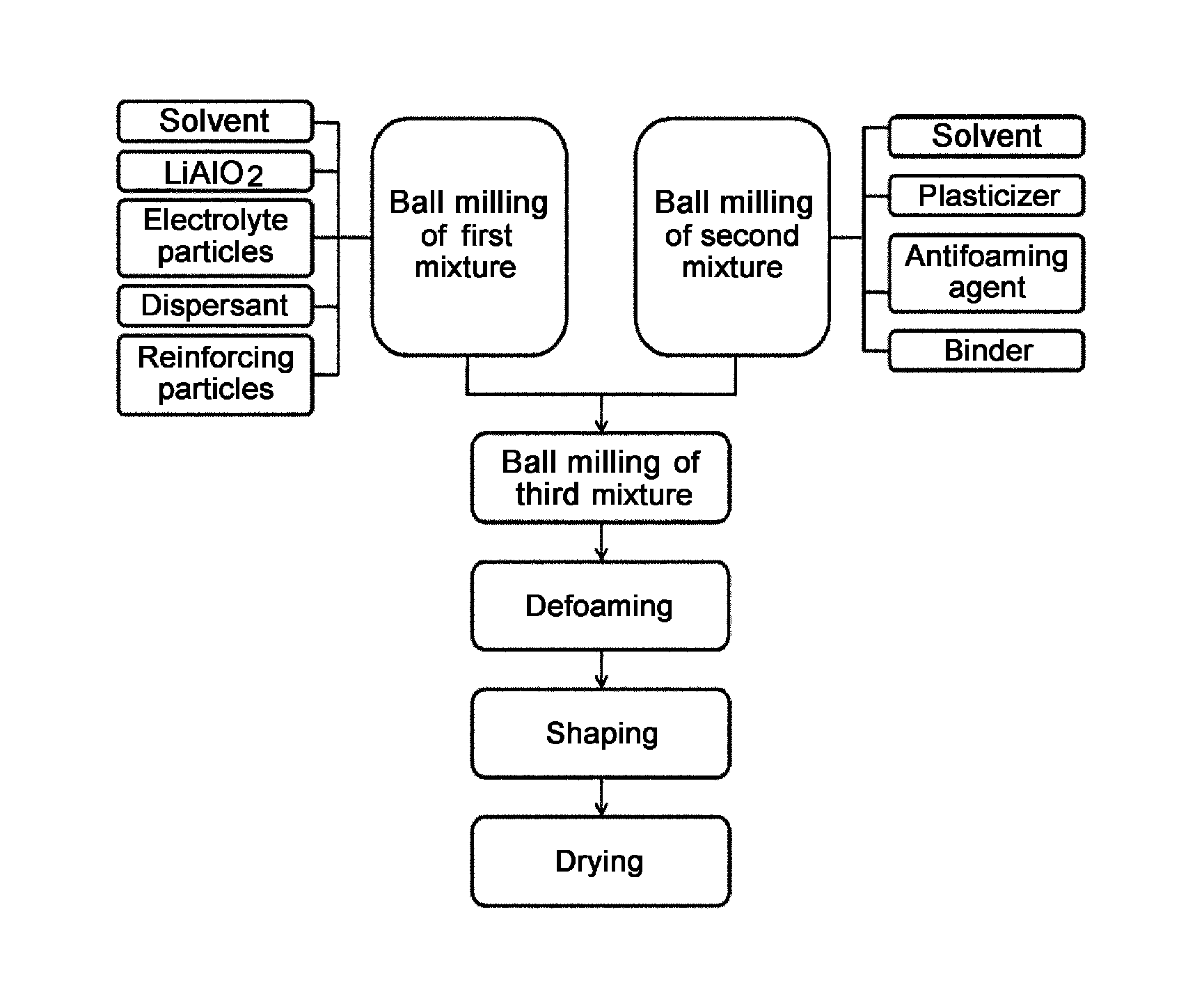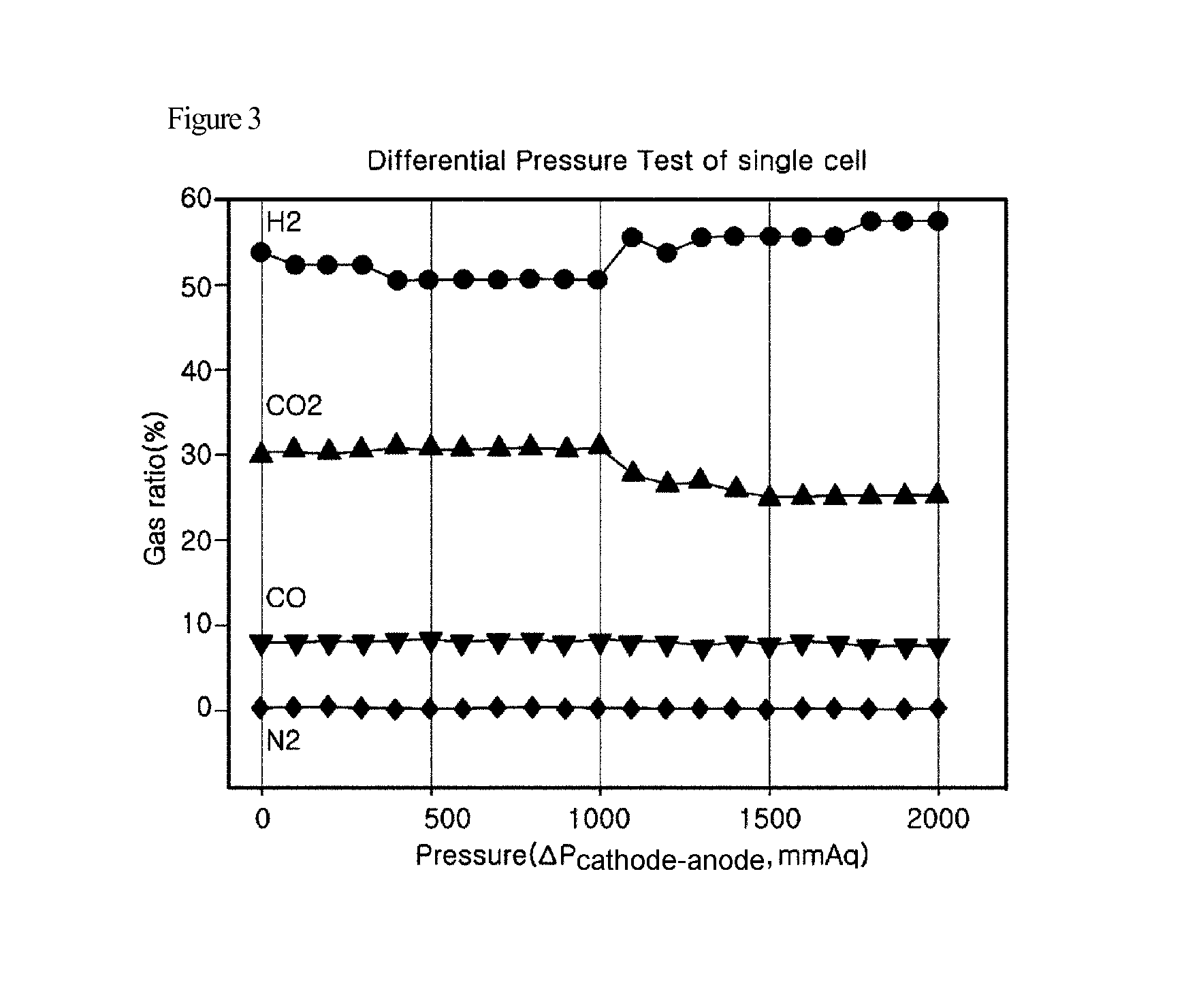Reinforced matrix impregnated with electrolytes for molten carbonate fuel cell and fabrication method thereof
a technology of reinforced matrix and fuel cell, which is applied in the direction of cell components, final product manufacturing, sustainable manufacturing/processing, etc., can solve the problems of matrix not being able to retain electrolyte, reducing production yield, and method not yielding the expected effect, etc., to achieve simplified matrix manufacturing process, reduce the effect of thermal expansion coefficient difference between electrolyte sheet and matrix
- Summary
- Abstract
- Description
- Claims
- Application Information
AI Technical Summary
Benefits of technology
Problems solved by technology
Method used
Image
Examples
examples 1 to 3
Fabrication of Electrolyte-Impregnated, Reinforced Matrix Using Reinforcing Metal Particles Together with Reinforcing Oxide Particles
[0056]According to the composition ratio in Table 1 below, the following components were prepared: a mixed solvent of ethyl alcohol and toluene (ethyl alcohol:toluene=7:3 w / w) as a solvent; LiAlO2 powder as the main component of a matrix; Li2CO3 and K2CO3 as an electrolyte; commercial dispersant SN-D348 as a dispersant; 3-μm Al particles as reinforcing metal particles; and 10-μm Al2O3 particles, 20-μm ZrO2 particles or 30-μm CeO2 particles as reinforcing oxide particles. The above components were mixed with each other and ball-milled, thus preparing powder slurry. In this regard, the electrolyte was prepared by grinding each of Li2CO3 and K2CO3 to a size of 1 to or less and mixing the ground materials with each other at a ratio of 70 mol %:30 mol % and was used in an amount corresponding to 40 vol % of the total pore volume of a matrix to be manufactur...
experimental example 1
Differential Pressure Test of Reinforced Matrix of the Present Invention
[0062]Each of the matrix reinforced with 3-μm aluminum particles and the matrix reinforced with 10-μm alumina particles, manufactured in Example 1, was subjected to a differential pressure test.
[0063]The differential pressure test was carried out using a single-cell system, in which the gas composition of an anode outlet was analyzed by GC while adjusting the pressure of a cathode outlet, and the durability of the matrix was evaluated based on whether N2 gas was detected.
[0064]The test results are shown in FIG. 3 which shows the results of detection of N2 gas in the anode outlet in a normal state in the pressure range from 0 to 2000 mmaq. As can be seen in FIG. 3, the reinforced matrix showed no detection of N2 gas in both the OCV state and the normal state even at a pressure of 2000 mmaq which is much higher than the design reference value of differential pressure, indicating that the reinforced matrix has exce...
PUM
| Property | Measurement | Unit |
|---|---|---|
| diameter | aaaaa | aaaaa |
| size | aaaaa | aaaaa |
| particle diameter | aaaaa | aaaaa |
Abstract
Description
Claims
Application Information
 Login to View More
Login to View More - R&D
- Intellectual Property
- Life Sciences
- Materials
- Tech Scout
- Unparalleled Data Quality
- Higher Quality Content
- 60% Fewer Hallucinations
Browse by: Latest US Patents, China's latest patents, Technical Efficacy Thesaurus, Application Domain, Technology Topic, Popular Technical Reports.
© 2025 PatSnap. All rights reserved.Legal|Privacy policy|Modern Slavery Act Transparency Statement|Sitemap|About US| Contact US: help@patsnap.com



